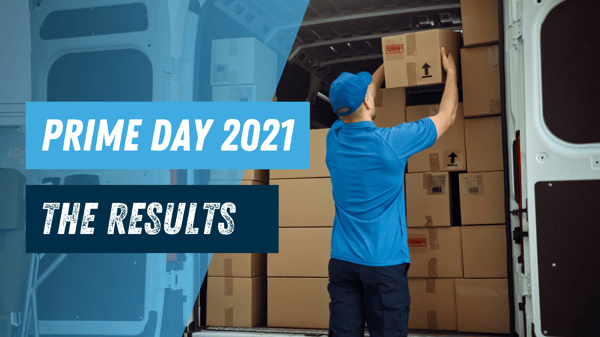Everything needs to come together in Q4. Your inventory management, promotion timing and PPC strategy should be dialed in well in advance of October. A lack of preparation during Q3 can turn a great year into a bad one.
The Bobsled project team makes a point of reviewing Prime Day performance data in order to plan out the rest of the year for our Amazon clients, with the flurry of spending that occurs during ‘Turkey 5’ being a major priority. Read on to learn more about what we observed during Prime Day 2021 and things to keep top of mind as Q4 approaches.

the big picture
Adobe Analytics estimated that total Prime Day 2021 sales surpassed $11 billion, a 6.1% increase compared to 2020. Some crucial factors that impacted this year’s event include:
- Rising US inflation. Electronics, Home Goods and Apparel – all high inflation categories – were the top Prime Day priorities for many shoppers according to the Prime Day 2021 Perceptions survey by Profitero.
- The recent shipping crisis in China hurt supply chains, and Amazon hobbled brands by announcing unexpected FBA inventory restrictions right before Prime Day.
- Amazon did their best to combat negative PR by implementing a strong Small Business focus – shoppers had the ability to use a new filter feature on the search results page which allowed them to buy exclusively from small businesses on Prime Day.
The Bobsled project team collectively agrees that Prime Day 2021 sales were strong, aligning with pre-event expectations, suggesting that an equally positive Q4 is on the horizon.
Bobsled Client ParticipatioN
Around two-thirds of Bobsled’s clients actively participated in Prime Day 2021, and most brands decided to promote their entire product catalog.
| Prime Day 2021 Approach | Percentage of Bobsled clients |
| Promoted entire product catalog | 30.9% |
| Promoted half of product catalog | 10.9% |
| Promoted best selling SKUs only | 16.4% |
| Showed last-minute interest | 5.5% |
| Low inventory levels prevented participation | 10.9% |
| Did not want to participate | 25.5% |
There were some noticeable differences in approach across categories. Brands selling within Health & Personal Care, Grocery & Gourmet Food and Beauty were far more inclined to promote their entire catalog. Brands selling within Tools & Home Improvement and Clothing, Shoes & Jewelry were more likely to only promote a handful of bestselling SKUs.
Promo Preference
Coupons and Prime Exclusive Discounts (PEDs) were by far the most popular promos run by Bobsled clients during Prime Day.
PPC Impressions
Average PPC impressions increased by 283% over the Prime Day period compared to the rolling 14-day average for Bobsled clients.
PPC clicks
Average PPC clicks increased by 255% over the Prime Day period compared to the rolling 14-day average for Bobsled clients.
PPC ad spend
Average PPC ad spend increased by 338% over the Prime Day period compared to the rolling 14-day average for Bobsled clients.
PPC ad sales
Average PPC ad sales increased by 464% over the Prime Day period compared to the rolling 14-day average for Bobsled clients.
total sales
Average total sales increased by 267% over the Prime Day period compared to the rolling 14-day average for Bobsled clients.
The Q4 rush is becoming harder to navigate and you NEED a strategic edge over your competitors. Get your Q4 readiness report and prepare for a successful season! Sign up here.
macro ppc trends
Bobsled’s ad tech partner Pacvue shared the following Prime Day 2021 data points:
- Ad spend increased 38% year-over-year for Prime Day 2021.
- Broken out by ad type, ad spend increased 41% for Sponsored Products and 28% for Sponsored Brands year-over-year.
- ROAS declined 9% year-over-year for Sponsored Products on the first day of Prime Day. This is in line with the 6% year-over-year decline in ROAS seen in Pacvue’s Q1 2021 CPC report.
- ROAS increased 30% year-over-year for Sponsored Brands on the first day of Prime Day and increased 23% on the second day. This is a marked shift for Sponsored Brand ads, which have been declining in ROAS for three quarters and were down 12% year-over-year in Pacvue’s Q1 2021 CPC report.
- Many advertisers noted that Sponsored Brand Video performed particularly well this year, with increased placements above the fold and on product detail pages.
- CPCs increased about 25% year-over-year for Sponsored Products and were relatively flat for Sponsored Brands.
- While some leading brands have been experiencing supply chain issues and chose not to invest in Prime Day this year, many advertisers noted increased competition from smaller and emerging sellers, which pushed up the cost of advertising.
🔔 Get Pacvue's full Prime Day 2021 CPC Report here
So, considering all of this Prime Day data, how should brands be preparing for Q4?
The fourth quarter does most of the heavy lifting in terms of revenue for the vast majority of brands selling on Amazon. In Q4 2020 Amazon delivered its largest revenue quarter of all time at $125.56 billion. There are some key things you can learn from Prime Day that will ensure you have a successful end to the year.
1) Keep your products in stock and Prime-eligible!
In Q4, getting your products to show up on Amazon with Prime-eligible offers while competitor offerings fall prey to stock-outs will give you a massive advantage. Inventory crunch trends are likely to continue, so tackle any supply chain headaches now – and get clear on your FBA replenishment strategy – to ensure your products are available throughout the entirety of Q4.
💡 Check out Amazon Q4 Inventory Planning
2) Use Prime Day performance data to map out your ‘Turkey 5’ strategy
Turkey 5 (T5) is the five day period between Thanksgiving and Cyber Monday, and as Day 2 of the event is Black Friday, sales on Amazon always go through the roof. This year T5 will span from Thursday November 25 to Monday November 29.
Brands should use their Prime Day performance results to map out anticipated metrics (especially around PPC) for each day of T5. Here’s an example;
Brand X Prime Day Ad Spend Day 1 = $1k
Brand X Prime Day Ad Spend Day 2 = $1.6k
Brand X Prime Day Ad Spend Daily Average = $1.3k
Therefore, Brand X should expect to spend an average of $1.3k on PPC for each day of T5, and a total of $6.5k on PPC over the 5-day period.
Brands should follow the same process to map out anticipated T5 results around Total Ad Sales, Total Sales and Total Unit Sales.
💡 Check out Bobsled’s Turkey 5 Prep Guide
3) Focus on promo strategies that work
To preserve your profit margins, stick with promos that get you good bang for your buck in Q4. Based on Prime Day results, Bobsled finds that Coupons and Prime Exclusive Discounts work best for most brands.
💡 Check out Which Amazon Promotions Work Best?
4) Use PPC ad types with the best ROI for your brand
Ad spend increased 38% year-over-year during Prime Day 2021, and this suggests a similar bump is on the horizon for Q4. Brands need to spend more to retain visibility on the platform during Q4, but simply increasing spend without a targeted strategy can really hurt your bottom line during peak traffic periods.
Review which ads had the best ROI for your brand during Prime Day and double down on those types during Q4. Also, if you have yet to launch any Sponsored Brand Video ads, start experimenting with this format in Q3.
💡 Check out Amazon Sponsored Brands Video Ads Best Practices
5) Use Amazon DSP to retarget browsing shoppers during Q4
Bobsled clients had some great successes retargeting browsing shoppers before, during and after Prime Day with Amazon DSP. This same strategy can be applied in Q4, especially in the aftermath of T5 in early December.
It takes time to develop seasonal creative, so getting ready in late Q3 to launch seasonal DSP ads in Q4 is a great idea. Analyzing your DSP data will help identify your top performing audiences and creative placements. An audience of customers in-market for your products, who have viewed but not purchased one of your ASINs in the last 90 days, is an ideal audience to retarget while you run big Q4 promos.
💡 Check out Amazon DSP Case Study

Tagged: Amazon Account Management, prime day, q4
.png)


